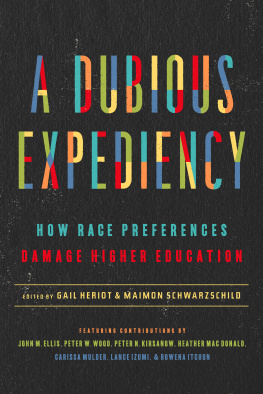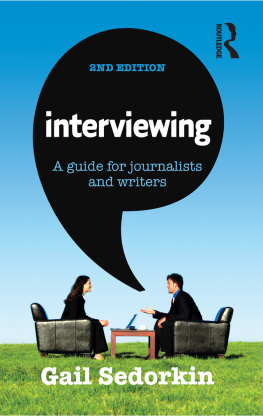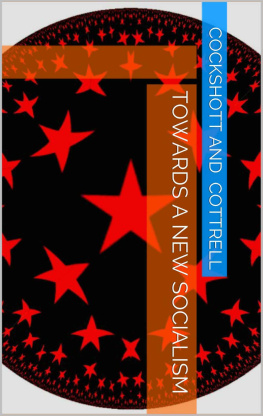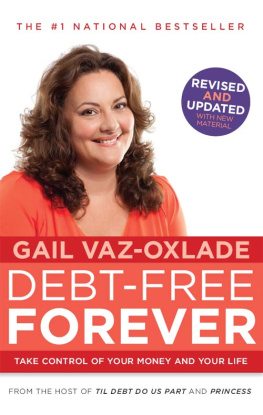Gail Heriot - A Dubious Expediency
Here you can read online Gail Heriot - A Dubious Expediency full text of the book (entire story) in english for free. Download pdf and epub, get meaning, cover and reviews about this ebook. year: 2021, publisher: Encounter Books, genre: Politics. Description of the work, (preface) as well as reviews are available. Best literature library LitArk.com created for fans of good reading and offers a wide selection of genres:
Romance novel
Science fiction
Adventure
Detective
Science
History
Home and family
Prose
Art
Politics
Computer
Non-fiction
Religion
Business
Children
Humor
Choose a favorite category and find really read worthwhile books. Enjoy immersion in the world of imagination, feel the emotions of the characters or learn something new for yourself, make an fascinating discovery.
- Book:A Dubious Expediency
- Author:
- Publisher:Encounter Books
- Genre:
- Year:2021
- Rating:3 / 5
- Favourites:Add to favourites
- Your mark:
- 60
- 1
- 2
- 3
- 4
- 5
A Dubious Expediency: summary, description and annotation
We offer to read an annotation, description, summary or preface (depends on what the author of the book "A Dubious Expediency" wrote himself). If you haven't found the necessary information about the book — write in the comments, we will try to find it.
A Dubious Expediency — read online for free the complete book (whole text) full work
Below is the text of the book, divided by pages. System saving the place of the last page read, allows you to conveniently read the book "A Dubious Expediency" online for free, without having to search again every time where you left off. Put a bookmark, and you can go to the page where you finished reading at any time.
Font size:
Interval:
Bookmark:

HOW RACE PREFERENCES DAMAGE HIGHER EDUCATION
EDITED BY
Gail Heriot and Maimon Schwarzschild

New York London
2021 by Gail Heriot and Maimon Schwarzschild; the individual chapters, the individual authors
All rights reserved. No part of this publication may be reproduced, stored in a retrieval system, or transmitted, in any form or by any means, electronic, mechanical, photocopying, recording, or otherwise, without the prior written permission of Encounter Books, 900 Broadway, Suite 601, New York, New York, 10003.
First American edition published in 2021 by Encounter Books, an activity of Encounter for Culture and Education, Inc., a nonprofit, tax-exempt corporation.
Encounter Books website address: www.encounterbooks.com
Manufactured in the United States and printed on acid-free paper. The paper used in this publication meets the minimum requirements of ANSI/NISO Z39.481992
(R 1997) (Permanence of Paper).
FIRST AMERICAN EDITION
LIBRARY OF CONGRESS CATALOGING-IN-PUBLICATION DATA
Names: Heriot, Gail, 1957 editor. | Schwarzschild, Maimon, 1951 editor.
Title: A dubious expediency: how race preferences damage higher education / edited by Gail Heriot and Maimon Schwarzschild.
Description: First American edition. | New York, NY: Encounter Books, 2021. Includes bibliographical references and index.
Identifiers: LCCN 2020044107 (print) | LCCN 2020044108 (ebook) ISBN 9781641771320 (cloth) | ISBN 9781641771337 (epub)
Subjects: LCSH: Discrimination in higher educationUnited States. Racism in higher educationUnited States. | Universities and colleges United StatesAdmission. | Education, HigherSocial aspectsUnited States.
Classification: LCC LC212.42.D83 2021 (print) | LCC LC212.42 (ebook) DDC 379.2/6dc23
LC record available at https://lccn.loc.gov/2020044107
LC ebook record available at https://lccn.loc.gov/2020044108
Interior page design and typesetting by Bruce Leckie
John M. Ellis
Gail Heriot
Peter W. Wood
Peter N. Kirsanow
Heather Mac Donald
Gail Heriot & Carissa Mulder
Lance Izumi & Rowena Itchon
Maimon Schwarzschild
Race preferences, under the rubric of affirmative action, have been a matter of policy in American higher education for more than half a century. More students have attended college during these years than during the long Jim Crow era.
In its early academic incarnation, and recurrently ever since in the public statements of some of its supporters, affirmative action was to seek out, and perhaps mildly to boost, minority applicants to colleges and universities, primarily on behalf of African Americans. In 1965, for example, Harvard Law School created a Special Summer Program for juniors and seniors from what later came to be called historically black colleges in the South. Harvards idea, modestly enough, was to encourage and try to qualify these students to enroll in its law school. Yet, in the same year, New York Universitys law faculty approved the admission of ten to fifteen students with test scores and college grades below the usual cutoff.
Preferential policies became more widespread, and far more aggressive, almost at once. By 1969, the American Association of Medical Colleges recommended that 12 percent of first-year medical students should be black. Affirmative-action programs, several of them financed by the Rockefeller Foundation, sought to recruit African American students from the inner city for admission to college and university, almost without concern for the students academic preparation. That same year, New Yorks City Universityknown in earlier decades as the Harvard of the proletariat for its academic excellencefirst created a dual admissions system whereby 50 percent of the class would still be admitted under academically selective standards but 50 percent would no longer be required to meet the standards; two months later, the City University dropped admissions standards altogether and introduced open admissions for all high school graduates.
At first, there was some tendency to acknowledge that preferences by raceand for other selected groupswere at odds with generally accepted, and usually desirable, principles of equal justice. Hence, preferences were often shrouded in euphemisms. As the tough liberal teachers union leader Albert Shanker reported disapprovingly, after a conversation in 1972 with Democratic presidential candidate George McGovern, the candidate is willing to abandon the word quota but still endorse the practice.
In the ensuing years and decades, what had been introduced and justified as a temporary expedient, with perhaps mild preferences for blacks just emerging from the era of Jim Crow, became a permanent featureand, increasingly, a predominating principleof higher education, with sometimes dramatically relaxed standards for applicants and students from an array of newly favored groups.
From the outset in the 1960s and 1970s, there were voices warning that race preferences (and preferences by ethnicity and sex as well), once established, would not be temporary, would not be modest in scope, and would not conduce toward social integration or reconciliation, but rather quite the contrary. As early as 1967, Ralph J. Winter, a Yale law professor who was later appointed to the United States Court of Appeals, wrote of preferential programs: Instead of helping to eliminate race from politics, they inject it. Instead of teaching tolerance and helping those forces seeking accommodation, they divide on a racial basis. In the mid-1970s, prominent public intellectual Nathan Glazer expressed his doubts in Affirmative Discrimination: EthnicInequality and Public Policy. At the time, Glazer criticized both the factual claims underlying preferential affirmative actionsuch as the idea of institutional racismand the implementation of preferences. These represented, said Glazer, a withdrawal from the acceptance of common standards, a weakening of our sense of rightness or justice in making academic judgments.
Fifty years and more have now elapsed, and race preferencesas well as preferences for other selected groupshave been thoroughly institutionalized in American higher education. Under the slogan of diversity, they have become a way of life, even an article of faith. Proliferating campus bureaucracies oversee and promote preferential policies. Preferences are an important factor not only in undergraduate and graduate admissions, but in hiring and promoting faculty and administrators as well. Preferences, and the preoccupation with race and group identity that they engender, increasingly affect the academic curriculum: in some fields, they virtually transform it. And preferences create ongoing pressure for lower academic standards, as institutions try to disguise the educational gap between students admitted preferentially and those admitted with standard qualifications.
Is it now too late to assess the edifice of racial and group preferences honestly and to suggest that American higher education has taken a wrong turn? We hopeand thinknot.
It is a matter of urgent current concern, as well as concern for the future, whether preferential affirmative action really fulfills its putative positive or desirable goals. These policies were first advancedand are sometimes still defendedas promoting racial integration. Yet college and university campuses, far from being more racially integrated, are increasingly segregated: on many campuses there are now racially separate dormitories, racially separate orientation and graduation ceremonies, and racially separate social lives. Even entire academic departments are effectively set aside racially.
Font size:
Interval:
Bookmark:
Similar books «A Dubious Expediency»
Look at similar books to A Dubious Expediency. We have selected literature similar in name and meaning in the hope of providing readers with more options to find new, interesting, not yet read works.
Discussion, reviews of the book A Dubious Expediency and just readers' own opinions. Leave your comments, write what you think about the work, its meaning or the main characters. Specify what exactly you liked and what you didn't like, and why you think so.









